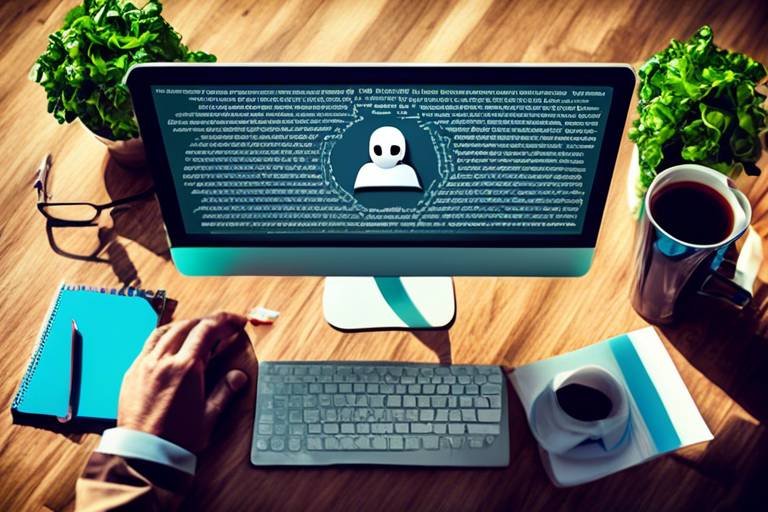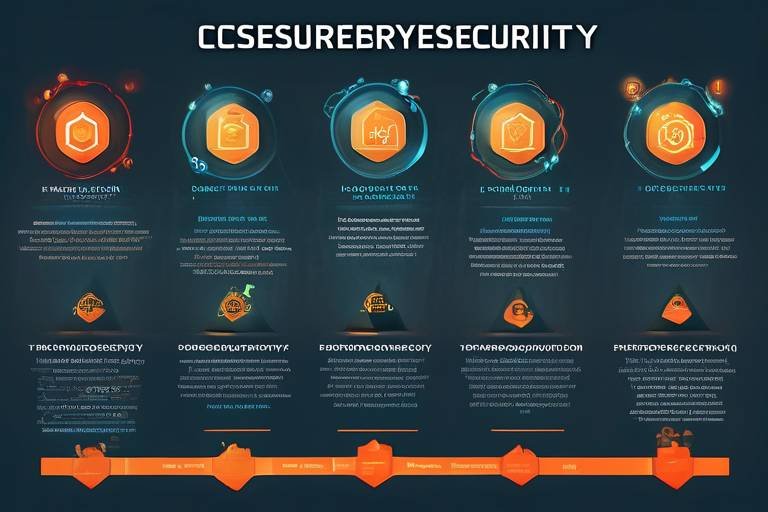Cybersecurity and Compliance in the Healthcare Industry
In today's digital age, the healthcare industry stands at a critical crossroads where cybersecurity and compliance converge. With the rapid advancement of technology, healthcare organizations are increasingly reliant on electronic systems to store and manage sensitive patient information. However, this reliance also exposes them to a multitude of cybersecurity threats that could compromise patient data and disrupt healthcare services. The stakes are incredibly high; a breach not only endangers patient privacy but can also lead to significant financial penalties and loss of trust. Therefore, understanding the intersection of cybersecurity and compliance is not just important—it's essential for the survival and success of healthcare organizations.
Compliance with regulations such as HIPAA (Health Insurance Portability and Accountability Act) is mandatory, but it's not merely a checkbox exercise. It requires a proactive approach to safeguarding patient data, ensuring that organizations develop robust cybersecurity strategies that align with regulatory standards. By prioritizing cybersecurity, healthcare providers can protect sensitive information while maintaining compliance, thus fostering trust with patients and stakeholders alike. This article delves into the crucial aspects of cybersecurity in healthcare, examining the key regulations that shape compliance, the common threats faced, and best practices that organizations can implement to fortify their defenses.
Cybersecurity is not just a technical issue; it's a fundamental component of patient care. Imagine walking into a hospital where your personal health information is as vulnerable as an open book. Would you feel safe? Probably not. This analogy underscores the importance of cybersecurity in healthcare. With patient trust hanging in the balance, healthcare organizations must take every precaution to ensure that sensitive information is protected from breaches.
Moreover, the implications of failing to secure patient data can be catastrophic. Beyond the immediate risk of financial loss, organizations face reputational damage that can take years to rebuild. Hence, understanding the significance of cybersecurity allows healthcare organizations to prioritize their security measures effectively. By investing in cybersecurity, they not only comply with regulations but also enhance their overall operational resilience.
Healthcare cybersecurity is governed by a complex web of regulations designed to protect patient information. Among the most significant are HIPAA, HITECH (Health Information Technology for Economic and Clinical Health Act), and GDPR (General Data Protection Regulation). Familiarity with these regulations is crucial for healthcare organizations as they navigate the intricate landscape of compliance. Each regulation has specific requirements that organizations must meet to protect patient data and avoid severe penalties.
| Regulation | Description |
|---|---|
| HIPAA | Establishes national standards for the protection of health information. |
| HITECH | Promotes the adoption of health information technology and strengthens HIPAA enforcement. |
| GDPR | Regulates data protection and privacy in the European Union and the European Economic Area. |
By understanding these regulations, healthcare organizations can implement necessary compliance measures, ensuring that they not only protect patient data but also maintain their credibility in the healthcare sector.
As we delve deeper into the cybersecurity landscape, it's crucial to recognize the various threats that healthcare organizations face. From ransomware attacks to phishing schemes, the range of potential risks is alarming. Identifying these threats is the first step in developing effective defense strategies. For instance, ransomware attacks can lock organizations out of their systems, demanding hefty sums for data recovery. This scenario not only disrupts operations but also jeopardizes patient care.
Additionally, phishing and social engineering tactics exploit human vulnerabilities to gain unauthorized access to sensitive information. Healthcare staff must be equipped with the knowledge to recognize these tactics and mitigate potential threats. A well-informed team is one of the best defenses against these common cybersecurity threats.
Implementing best practices for cybersecurity compliance is essential for healthcare organizations striving to enhance their security posture. Regular employee training and awareness programs can significantly reduce risks associated with human error. When staff members understand the importance of cybersecurity and are trained to recognize potential threats, they become a vital line of defense.
Moreover, conducting regular risk assessments allows organizations to identify vulnerabilities and implement appropriate measures. This proactive approach not only aids in maintaining compliance but also ensures that organizations are prepared to face evolving cybersecurity threats.
- What is the most common cybersecurity threat in healthcare? Ransomware attacks are among the most prevalent threats faced by healthcare organizations.
- How can healthcare organizations ensure HIPAA compliance? By implementing robust security measures, conducting regular risk assessments, and providing employee training.
- What role does employee training play in cybersecurity? Employee training is crucial as it helps staff recognize and respond to potential threats, reducing the risk of breaches.

The Importance of Cybersecurity in Healthcare
In today's digital age, cybersecurity has become a cornerstone of the healthcare industry. With the rapid advancement of technology, healthcare organizations are increasingly reliant on electronic systems to manage patient data. However, this reliance also opens the door to potential cyber threats that can compromise sensitive information. Imagine a hospital's network being breached, leading to the exposure of thousands of patients' personal and medical records. This scenario is not just a hypothetical situation; it happens more often than we think. In fact, the healthcare sector is one of the most targeted industries for cyberattacks, making robust cybersecurity measures absolutely essential.
Protecting patient information is not just about safeguarding data; it’s about maintaining trust. Patients need to feel secure that their private health information is protected. When a breach occurs, it can lead to a loss of trust that is difficult to restore. Moreover, healthcare organizations must adhere to stringent regulations like HIPAA, which mandates the protection of patient data. Non-compliance can result in hefty fines and legal repercussions, making it critical for organizations to prioritize cybersecurity.
The importance of cybersecurity in healthcare can be summarized in several key points:
- Protection of Sensitive Data: Cybersecurity measures help safeguard personal health information from unauthorized access and breaches.
- Regulatory Compliance: Adhering to laws such as HIPAA ensures that healthcare organizations avoid penalties and maintain their licenses.
- Operational Continuity: Effective cybersecurity strategies minimize the risk of disruptions to healthcare services, ensuring that care can be delivered without interruption.
- Patient Trust: A strong cybersecurity posture fosters trust between patients and providers, which is vital for effective healthcare delivery.
Furthermore, the financial implications of a cybersecurity breach can be staggering. A single incident can cost an organization millions of dollars in recovery, legal fees, and lost business. Not to mention the potential for lawsuits from affected patients. Therefore, investing in cybersecurity is not just a technical necessity; it’s a financial imperative.
In conclusion, the intersection of cybersecurity and healthcare is not merely a compliance issue; it’s a fundamental aspect of patient care and organizational integrity. By prioritizing cybersecurity, healthcare organizations can protect their patients, comply with regulations, and ensure the sustainability of their operations in an increasingly digital world.

Key Regulations Impacting Healthcare Cybersecurity
In the rapidly evolving world of healthcare, cybersecurity is not just a luxury—it's a necessity. The healthcare sector is a treasure trove of sensitive patient information, making it a prime target for cybercriminals. To effectively protect this data, healthcare organizations must navigate a complex landscape of regulations designed to ensure patient privacy and data security. Understanding these regulations is crucial for any healthcare provider aiming to maintain compliance and safeguard patient information.
Among the most significant regulations impacting healthcare cybersecurity are HIPAA, HITECH, and GDPR. Each of these regulations comes with its own set of requirements that healthcare organizations must adhere to, and familiarity with these laws is essential for compliance and risk mitigation.
HIPAA, or the Health Insurance Portability and Accountability Act, sets national standards for the protection of health information. It mandates the implementation of various safeguards to ensure the confidentiality, integrity, and availability of patient data. Non-compliance can lead to hefty fines and legal repercussions, making it imperative for healthcare organizations to understand and implement HIPAA regulations effectively.
Following closely is the HITECH Act, which was enacted to promote the adoption of electronic health records (EHRs) and strengthen the enforcement of HIPAA. This act not only incentivizes healthcare providers to adopt technology but also imposes stricter penalties for HIPAA violations. As such, organizations must remain vigilant and proactive in their cybersecurity practices to comply with HITECH requirements.
Lastly, the General Data Protection Regulation (GDPR) has implications for healthcare organizations that operate in or have ties to the European Union. GDPR emphasizes the importance of data protection and privacy, granting patients more control over their personal information. For healthcare providers, compliance with GDPR means implementing comprehensive data protection measures and being transparent about how patient data is used.
To summarize, the following table highlights the key regulations impacting healthcare cybersecurity:
| Regulation | Key Focus | Implications for Healthcare |
|---|---|---|
| HIPAA | Protection of health information | Mandatory safeguards and penalties for non-compliance |
| HITECH | Adoption of health IT and enforcement of HIPAA | Increased penalties for HIPAA violations |
| GDPR | Data protection and privacy | Enhanced patient rights and transparency requirements |
In conclusion, navigating the regulatory landscape of healthcare cybersecurity is no small feat. However, by understanding the key regulations like HIPAA, HITECH, and GDPR, healthcare organizations can better prepare themselves to protect sensitive patient data and avoid costly penalties. This proactive approach not only enhances security measures but also fosters trust among patients, ensuring that their information is handled with the utmost care and respect.
- What is HIPAA and why is it important? HIPAA is a federal law that establishes national standards for the protection of health information, ensuring patient privacy and data security.
- How does the HITECH Act strengthen HIPAA? The HITECH Act promotes the adoption of electronic health records and imposes stricter penalties for HIPAA violations, enhancing overall compliance.
- What are the implications of GDPR for healthcare organizations? GDPR requires healthcare organizations to implement robust data protection measures and gives patients greater control over their personal information.

HIPAA Compliance Requirements
Understanding is a fundamental step for any healthcare organization aiming to protect patient information. The Health Insurance Portability and Accountability Act (HIPAA) sets forth a series of regulations that ensure the privacy and security of health data. Compliance is not just a legal obligation; it’s a commitment to safeguarding the trust that patients place in healthcare providers. In this section, we'll delve into the key components of HIPAA compliance, discussing how organizations can align their practices with these requirements to avoid costly penalties and data breaches.
At the heart of HIPAA are two primary rules: the Privacy Rule and the Security Rule. Each of these rules has distinct requirements that healthcare entities must adhere to:
| Rule | Description | Key Requirements |
|---|---|---|
| Privacy Rule | Establishes standards for the protection of health information. |
|
| Security Rule | Mandates safeguards to protect electronic health information. |
|
The Privacy Rule is particularly significant as it outlines the rights of patients regarding their health information. Patients must be informed about how their information is used and shared. This means healthcare providers must have clear policies in place to ensure compliance. For instance, organizations must provide patients with a Notice of Privacy Practices that details their rights and the organization’s responsibilities under HIPAA.
On the other hand, the Security Rule focuses on the technical and administrative safeguards that must be implemented to protect electronic health information (ePHI). This includes not only the use of technology but also the establishment of policies and procedures to manage the security of ePHI. Healthcare organizations are required to conduct a risk assessment to identify potential vulnerabilities and implement measures to mitigate these risks.
In addition to the Privacy and Security Rules, organizations must also be aware of the Breach Notification Rule, which requires them to notify affected individuals and the Department of Health and Human Services (HHS) in the event of a data breach. This rule emphasizes the importance of transparency and accountability in handling sensitive patient information.
Ultimately, achieving HIPAA compliance is an ongoing process that requires continuous evaluation and adaptation. As technology evolves and new threats emerge, healthcare organizations must remain vigilant and proactive in their approach to data protection. By fostering a culture of compliance and security awareness, organizations can not only meet regulatory requirements but also build trust with their patients, ensuring that their sensitive information is always protected.
Q: What is HIPAA?
A: HIPAA stands for the Health Insurance Portability and Accountability Act, a federal law designed to protect patient health information.
Q: Who must comply with HIPAA?
A: HIPAA applies to healthcare providers, health plans, and healthcare clearinghouses that handle protected health information (PHI).
Q: What are the penalties for non-compliance?
A: Penalties for HIPAA non-compliance can range from fines to criminal charges, depending on the severity of the violation.
Q: How often should organizations conduct risk assessments?
A: Organizations should conduct risk assessments regularly, at least annually, or whenever there are significant changes to their operations or technology.

Privacy Rule
The HIPAA Privacy Rule is a cornerstone of patient data protection in the healthcare industry. Established to ensure that sensitive patient information remains confidential, this rule sets national standards for the handling of health information. Have you ever wondered how your personal health data is kept safe? The Privacy Rule mandates that healthcare providers, health plans, and other entities that handle health information must implement stringent measures to protect this data from unauthorized access and disclosure.
One of the key components of the Privacy Rule is the requirement for healthcare organizations to provide patients with a Notice of Privacy Practices. This document outlines how their health information may be used and shared, as well as the patients' rights regarding their data. It’s essential for organizations to communicate this information clearly, as it builds trust and empowers patients to take control of their health information.
Moreover, the Privacy Rule emphasizes the importance of patient consent. Organizations must obtain explicit permission from patients before using or disclosing their health information for purposes other than treatment, payment, or healthcare operations. This is akin to asking for someone’s permission before sharing their personal secrets—trust is fundamental in the patient-provider relationship.
Let's explore some of the key implications of the Privacy Rule for healthcare providers:
- Access Controls: Organizations must implement access controls to ensure that only authorized personnel can view patient information.
- Training and Awareness: Staff must be trained on privacy practices and the importance of safeguarding patient information.
- Data Breach Notification: In the event of a data breach, organizations are required to notify affected individuals promptly.
In essence, the Privacy Rule is not just a set of guidelines; it is a framework that underpins the ethical responsibility of healthcare providers to protect patient privacy. By adhering to these standards, healthcare organizations not only comply with regulations but also foster a culture of trust and respect with their patients. This is crucial in a time when data breaches are becoming increasingly common. Protecting patient information is not only about avoiding penalties; it’s about safeguarding the very foundation of healthcare relationships.
- What is the HIPAA Privacy Rule?
The HIPAA Privacy Rule establishes national standards for the protection of health information, ensuring that patient data is kept confidential and secure. - Who must comply with the Privacy Rule?
Healthcare providers, health plans, and any entity that handles patient health information must comply with the Privacy Rule. - What are patients' rights under the Privacy Rule?
Patients have the right to access their health information, request corrections, and receive a notice of how their data is used.

Security Rule
The HIPAA Security Rule is a pivotal component of the overall framework that governs the protection of electronic health information (ePHI). This rule sets forth a series of standards that healthcare organizations must adhere to in order to safeguard sensitive patient data from unauthorized access, breaches, and other potential threats. Essentially, the Security Rule is like a security blanket for patient information, ensuring that it remains confidential and secure in an increasingly digital world.
At its core, the Security Rule is built on three main pillars: administrative safeguards, physical safeguards, and technical safeguards. Each of these categories encompasses a variety of specific measures that organizations must implement to ensure compliance. Here’s a brief overview of what each entails:
| Safeguard Type | Description |
|---|---|
| Administrative Safeguards | Policies and procedures designed to manage the selection, development, implementation, and maintenance of security measures to protect ePHI. |
| Physical Safeguards | Measures to protect the physical facilities and equipment that store ePHI from unauthorized access and environmental hazards. |
| Technical Safeguards | Technology and related policies that protect ePHI and control access to it, including encryption and access controls. |
To elaborate, administrative safeguards include training programs for employees, security management processes, and contingency planning. These measures are essential for creating a culture of security awareness within the organization. Without proper training, even the best technical safeguards can be rendered ineffective if employees are unaware of their responsibilities.
On the other hand, physical safeguards involve securing the facilities where ePHI is stored. This can include installing security cameras, using locks, and controlling who has access to certain areas. Imagine a hospital as a fortress; if the doors are left unlocked, no amount of security software can keep intruders at bay.
Finally, technical safeguards are the technological measures that protect ePHI. This includes implementing strong passwords, using encryption for data transmission, and employing firewalls to prevent unauthorized access. Think of these as the digital locks and alarms that protect the fortress of patient data.
In summary, the Security Rule is not just a set of guidelines; it is a comprehensive framework designed to protect sensitive patient information from various threats. Healthcare organizations must take these requirements seriously, as non-compliance can lead to severe penalties, including hefty fines and damage to their reputation. By understanding and implementing the necessary safeguards, organizations can create a secure environment that not only protects patient data but also fosters trust among patients and stakeholders alike.
- What is the main purpose of the HIPAA Security Rule?
The main purpose is to ensure the confidentiality, integrity, and availability of electronic protected health information (ePHI). - What are the consequences of non-compliance with the Security Rule?
Organizations may face significant fines, legal action, and damage to their reputation. - How often should healthcare organizations conduct risk assessments?
It is recommended to conduct risk assessments at least annually or whenever there are significant changes to the organization or its operations.

HITECH Act and Its Implications
The Health Information Technology for Economic and Clinical Health (HITECH) Act was enacted in 2009 as part of the American Recovery and Reinvestment Act. This pivotal legislation aims to promote the adoption of health information technology, particularly electronic health records (EHRs), while also enhancing the enforcement of the Health Insurance Portability and Accountability Act (HIPAA). The implications of the HITECH Act are profound, as it provides a framework that not only encourages healthcare organizations to modernize their systems but also imposes stricter penalties for breaches of patient information.
One of the most significant aspects of the HITECH Act is its emphasis on the meaningful use of EHRs. This means that healthcare providers must demonstrate that they are using certified EHR technology in ways that can be measured significantly in quality and in quantity. Failure to achieve meaningful use can result in financial penalties, which adds a layer of urgency for healthcare organizations to comply with these standards. As a result, the HITECH Act has spurred many healthcare entities to invest in cybersecurity measures that protect patient data while simultaneously improving their operational efficiency.
Moreover, the HITECH Act strengthens the breach notification requirements under HIPAA. Organizations must now notify affected individuals, the Department of Health and Human Services (HHS), and sometimes the media in the event of a data breach involving unsecured protected health information (PHI). This transparency is intended to empower patients by keeping them informed about how their data is being managed and protected.
In terms of cybersecurity, the HITECH Act has led to an increased focus on risk management and compliance strategies among healthcare organizations. Many are now adopting integrated cybersecurity frameworks that not only address immediate threats but also align with the long-term goals of maintaining regulatory compliance. Here are some implications that healthcare organizations need to consider:
- Increased Funding: The HITECH Act provides financial incentives for healthcare providers who demonstrate meaningful use of EHRs, which can help fund necessary cybersecurity upgrades.
- Stricter Penalties: Non-compliance with HIPAA standards can lead to hefty fines, and HITECH has made these penalties even more severe, urging organizations to prioritize their cybersecurity efforts.
- Enhanced Enforcement: The Act enables state attorneys general to enforce HIPAA compliance, broadening the scope of accountability for healthcare organizations.
In conclusion, the HITECH Act serves as a catalyst for change in the healthcare sector, pushing organizations to adopt advanced technologies while ensuring they have robust cybersecurity measures in place. As the landscape of healthcare continues to evolve, the importance of understanding and complying with the HITECH Act cannot be overstated. Organizations that proactively embrace these changes are not only protecting their patients but also positioning themselves for success in an increasingly digital world.
1. What is the HITECH Act?
The HITECH Act is legislation that promotes the adoption of health information technology and strengthens the enforcement of HIPAA regulations.
2. How does the HITECH Act impact cybersecurity in healthcare?
It encourages healthcare organizations to enhance their cybersecurity measures to protect electronic health information and comply with stricter regulations.
3. What are the penalties for non-compliance with the HITECH Act?
Organizations can face substantial fines and penalties for failing to comply with HIPAA standards as enforced by the HITECH Act.
4. What is "meaningful use" under the HITECH Act?
Meaningful use refers to the effective use of certified EHR technology by healthcare providers to improve patient care quality and efficiency.

Common Cybersecurity Threats in Healthcare
The healthcare industry is a treasure trove of sensitive information, making it a prime target for cybercriminals. As technology advances, so do the tactics employed by these malicious actors. Understanding the common cybersecurity threats faced by healthcare organizations is crucial in developing effective defense strategies. Among the most prevalent threats are ransomware attacks, phishing, and insider threats. Each of these poses unique challenges and potential repercussions for patient care and organizational integrity.
Ransomware attacks have become notorious in recent years, often leading to significant operational disruptions. Imagine a hospital's electronic health records system being locked down, leaving healthcare providers unable to access vital patient information. This not only compromises patient care but can also result in hefty financial losses. According to a report by Cybersecurity Ventures, ransomware is projected to cause damages exceeding $265 billion annually by 2031. Organizations must prepare by implementing robust backup solutions and incident response plans to mitigate the impact of such attacks.
Another common threat is phishing, where cybercriminals use deceptive emails or messages to trick healthcare staff into revealing sensitive information. These attacks exploit human vulnerabilities, often resulting in unauthorized access to patient data. For instance, a staff member might receive an email that appears to be from an official source, prompting them to click a malicious link. Educating employees about recognizing phishing attempts is essential, as they are often the first line of defense against such threats.
Furthermore, insider threats can be equally damaging, whether they stem from malicious intent or simple negligence. Employees with access to sensitive data may inadvertently expose it through careless actions or may be coerced into leaking information. Organizations must foster a culture of security awareness, encouraging employees to report suspicious activities and adhere to strict access controls. By doing so, healthcare providers can significantly reduce the risk of insider threats.
To put these threats into perspective, consider the following table that outlines their potential impacts:
| Threat Type | Potential Impact | Mitigation Strategies |
|---|---|---|
| Ransomware | Operational disruption, data loss, financial penalties | Regular backups, incident response plans, employee training |
| Phishing | Unauthorized access to sensitive information, data breaches | Employee training, email filtering, multi-factor authentication |
| Insider Threats | Data leaks, compliance violations, reputational damage | Access controls, monitoring, security awareness programs |
In conclusion, the cybersecurity landscape in healthcare is fraught with challenges. By understanding these common threats and implementing effective mitigation strategies, healthcare organizations can better protect themselves and their patients. As the saying goes, "An ounce of prevention is worth a pound of cure," and this is especially true in the realm of cybersecurity.
Q: What is ransomware, and how does it affect healthcare?
A: Ransomware is a type of malware that encrypts a victim's files, rendering them inaccessible until a ransom is paid. In healthcare, this can lead to operational disruptions and jeopardize patient care.
Q: How can healthcare organizations protect against phishing attacks?
A: Organizations can protect against phishing by conducting regular employee training, implementing email filtering solutions, and utilizing multi-factor authentication to add an extra layer of security.
Q: What are insider threats, and how can they be mitigated?
A: Insider threats refer to risks posed by employees or contractors who have access to sensitive information. Mitigation strategies include strict access controls, monitoring employee activities, and fostering a culture of security awareness.

Ransomware Attacks
Ransomware attacks have become one of the most daunting threats facing healthcare organizations today. Imagine waking up one morning to find that all your patient data has been locked away, inaccessible until a hefty ransom is paid. This is the harsh reality many healthcare providers have faced in recent years, highlighting the critical need for robust cybersecurity measures. Ransomware not only disrupts operations but can also lead to devastating consequences, including the loss of sensitive patient information and a breakdown of trust between providers and patients.
These attacks typically occur when malicious software infiltrates a network, encrypting files and rendering them unusable. Cybercriminals then demand a ransom, often in cryptocurrency, to provide the decryption key. The stakes are incredibly high in the healthcare sector, where timely access to patient data can mean the difference between life and death. In fact, according to a report by the Cybersecurity & Infrastructure Security Agency (CISA), healthcare organizations are targeted more frequently than any other sector, making it imperative for these organizations to adopt effective prevention and response strategies.
To combat ransomware, healthcare organizations should consider implementing a multi-layered security approach. This includes:
- Regular Data Backups: Consistently backing up data ensures that, in the event of an attack, organizations can restore their systems without paying the ransom.
- Employee Training: Educating staff on recognizing phishing attempts and suspicious activities can significantly reduce the chances of a successful attack.
- Network Segmentation: Dividing networks into smaller, isolated segments can prevent ransomware from spreading across the entire system.
- Advanced Threat Detection Tools: Utilizing sophisticated software to detect and respond to anomalies can help identify potential threats before they escalate.
Moreover, having a well-defined incident response plan is crucial. This plan should outline the steps to take in the event of a ransomware attack, including communication protocols, data recovery procedures, and engagement with law enforcement. It’s also essential to regularly test and update this plan to adapt to the evolving threat landscape.
In conclusion, while ransomware attacks pose a significant risk to healthcare organizations, proactive measures can mitigate these threats. By investing in robust cybersecurity practices and fostering a culture of security awareness, healthcare providers can better protect their patients' sensitive information and maintain the trust that is so vital in the healthcare industry.
Q: What is ransomware?
A: Ransomware is a type of malicious software that encrypts a victim's files, demanding payment for the decryption key.
Q: How can healthcare organizations prepare for ransomware attacks?
A: Organizations can prepare by implementing regular data backups, employee training, network segmentation, and using advanced threat detection tools.
Q: Is paying the ransom a good idea?
A: Paying the ransom does not guarantee that you will regain access to your data and may encourage further attacks. It's usually better to focus on prevention and recovery strategies.
Q: What should be included in an incident response plan?
A: An incident response plan should include communication protocols, data recovery procedures, and engagement strategies with law enforcement in the event of a ransomware attack.

Phishing and Social Engineering
Phishing and social engineering are two of the most insidious threats facing healthcare organizations today. These tactics exploit the human element, often rendering even the most sophisticated security systems ineffective. Imagine a well-crafted email that appears to come from a trusted source, like a colleague or a reputable vendor. It contains a link that, when clicked, opens the door to a hacker's paradise. This scenario is not just a figment of imagination; it’s a reality that many healthcare professionals face daily.
Phishing attacks are often disguised as legitimate communication, making it incredibly difficult for employees to discern between what is real and what is a trap. These attacks can take many forms, including:
- Email Phishing: The most common form, where attackers send emails that look legitimate to trick users into providing sensitive information.
- Spear Phishing: A targeted attempt to steal sensitive information from a specific individual or organization, often using personalized information.
- Whaling: A type of spear phishing that targets high-profile individuals within an organization, such as executives.
Social engineering, on the other hand, is a broader term that encompasses various tactics used to manipulate individuals into divulging confidential information. This can occur through phone calls, in-person interactions, or even social media. For instance, an attacker might pose as a tech support agent and request login credentials under the guise of performing maintenance. The success of these tactics often hinges on the attacker’s ability to build trust and exploit the victim's emotions, such as fear or urgency.
To combat these threats, healthcare organizations must prioritize employee training and awareness. Regular workshops and training sessions can equip staff with the knowledge to recognize suspicious communications and respond appropriately. It's essential to foster a culture of skepticism and vigilance where employees feel empowered to question unusual requests or communications, no matter how legitimate they may seem.
Furthermore, implementing robust security measures can help mitigate the risks associated with phishing and social engineering. This includes:
- Multi-Factor Authentication (MFA): Adds an additional layer of security, making it harder for attackers to gain access even if they acquire login credentials.
- Regular Security Audits: Helps identify vulnerabilities in existing systems and processes, allowing organizations to fortify their defenses.
- Incident Response Plans: Preparing a clear action plan for responding to suspected phishing attempts can greatly reduce potential damage.
In conclusion, understanding the nuances of phishing and social engineering is crucial for healthcare organizations striving to protect sensitive patient data. By combining employee education with robust security practices, healthcare providers can create a formidable defense against these pervasive threats. Remember, in the fight against cybercrime, the best offense is a well-informed and vigilant workforce.
Q1: What are the signs of a phishing email?
A1: Common signs include misspellings, generic greetings, urgent language, and suspicious links or attachments. Always verify the sender's email address before clicking on any links.
Q2: How can I train my staff to recognize social engineering attacks?
A2: Conduct regular training sessions that include real-life examples, simulations, and discussions about the importance of verifying requests for sensitive information.
Q3: What should I do if I suspect a phishing attack?
A3: Report the incident to your IT department immediately, do not click on any links, and follow your organization's incident response plan.

Best Practices for Cybersecurity Compliance
In the ever-evolving landscape of healthcare, where patient data is a goldmine for cybercriminals, implementing robust cybersecurity compliance practices is not just a recommendation—it's a necessity. Think of cybersecurity like a fortress; without the right walls and defenses, the treasures within are at risk of being plundered. So, how can healthcare organizations fortify their defenses and ensure compliance with regulations? Here are some essential strategies that can bolster your cybersecurity posture.
First and foremost, employee training and awareness are paramount. Regular training programs are crucial for keeping staff informed about the latest cybersecurity threats and best practices. Imagine your employees as the first line of defense against cyber threats; if they are untrained, it’s like sending soldiers into battle without armor. By fostering a culture of security awareness, healthcare organizations can significantly reduce risks associated with human error. This includes recognizing phishing attempts, understanding the importance of strong passwords, and knowing how to respond to suspicious activities.
In addition to training, conducting regular risk assessments is vital. These assessments act as a health check for your cybersecurity measures, allowing you to identify vulnerabilities before they can be exploited. Think of it as a routine medical check-up; just as you would want to catch health issues early, you need to proactively discover and address potential cybersecurity weaknesses. A systematic approach to risk assessments involves:
| Step | Description |
|---|---|
| Identify Assets | Catalog all sensitive data, systems, and processes that need protection. |
| Evaluate Risks | Analyze potential threats and vulnerabilities associated with identified assets. |
| Implement Controls | Put in place necessary safeguards to mitigate identified risks. |
| Monitor and Review | Continuously monitor the effectiveness of controls and adjust as needed. |
Moreover, healthcare organizations should prioritize incident response planning. Having a well-defined and rehearsed incident response plan is akin to having a fire drill; it prepares your team for action when the alarm goes off. This plan should outline the steps to take in the event of a cybersecurity incident, ensuring that everyone knows their roles and responsibilities. A swift and coordinated response can make all the difference in minimizing damage and restoring normal operations.
Another integral aspect of cybersecurity compliance is data encryption. Encrypting sensitive patient information adds an additional layer of protection, ensuring that even if data is intercepted, it remains unreadable without the appropriate decryption keys. This is especially crucial for organizations that handle electronic health records (EHRs) and other sensitive data. Think of encryption as a secret code that only authorized personnel can decipher, safeguarding patient information from prying eyes.
Lastly, it’s essential to stay updated with the latest cybersecurity trends and regulatory changes. The landscape is constantly shifting, and what was considered secure yesterday may not hold up against today's threats. Regularly reviewing and updating your cybersecurity policies and practices ensures that your organization remains compliant and prepared for new challenges. Consider subscribing to industry newsletters, attending relevant conferences, and participating in professional networks to keep your knowledge fresh.
In summary, adopting these best practices not only enhances your organization’s cybersecurity posture but also fosters a culture of compliance that protects both patient data and the integrity of your healthcare institution. By prioritizing employee training, conducting regular risk assessments, planning for incidents, encrypting data, and staying informed, healthcare organizations can navigate the complex world of cybersecurity with confidence.
- What is the best way to train employees on cybersecurity?
Regular workshops, online courses, and simulated phishing exercises can effectively engage employees and enhance their awareness. - How often should risk assessments be conducted?
It's recommended to perform risk assessments at least annually, or more frequently if there are significant changes in your systems or processes. - What should be included in an incident response plan?
An incident response plan should outline roles, communication protocols, and steps to contain and mitigate incidents, as well as recovery procedures.

Employee Training and Awareness
In the ever-evolving landscape of cybersecurity, particularly within the healthcare sector, the role of cannot be overstated. Imagine your organization as a fortress; no matter how strong the walls, if the gates are left unguarded, intruders will find a way in. In this analogy, your employees are the gatekeepers. They must be equipped with the knowledge and skills to recognize potential threats and respond effectively.
Regular training programs are essential for fostering a culture of security awareness among staff. These programs should not only cover the basics of cybersecurity but also delve into the specific threats that healthcare organizations face. For instance, employees should be educated on ransomware attacks, phishing schemes, and social engineering tactics that are increasingly targeting healthcare facilities. By understanding these threats, employees can act as the first line of defense, preventing breaches before they occur.
Moreover, effective training should be ongoing rather than a one-time event. Cybersecurity threats are constantly evolving, and so should the knowledge of your employees. Implementing a structured training schedule that includes:
- Initial onboarding sessions for new hires
- Quarterly refresher courses for all staff
- Annual assessments to gauge knowledge retention and identify areas for improvement
is crucial for maintaining a high level of awareness. Additionally, utilizing real-world scenarios during training can significantly enhance understanding. For example, conducting simulated phishing attacks allows employees to experience firsthand what such an attack looks like, making them more likely to recognize and respond appropriately to actual threats.
Another vital aspect of employee training is the promotion of a security-first mindset. Encourage staff to report suspicious activities without fear of repercussions. This open communication fosters a sense of responsibility among employees, making them feel like integral parts of the organization’s cybersecurity strategy. When every team member understands their role in protecting sensitive data, the overall security posture of the organization improves.
In summary, investing in employee training and awareness is not just a checkbox on a compliance list; it is a fundamental component of a robust cybersecurity strategy in healthcare. By empowering your staff with the right knowledge and tools, you can significantly reduce vulnerabilities and enhance your organization's ability to protect sensitive patient information.
Q1: Why is employee training important in healthcare cybersecurity?
A1: Employee training is crucial as it equips staff with the knowledge to recognize and respond to cybersecurity threats, thereby acting as a vital line of defense against potential breaches.
Q2: How often should training sessions be conducted?
A2: Training should be ongoing, with initial sessions for new hires, quarterly refreshers for all staff, and annual assessments to ensure knowledge retention and adapt to new threats.
Q3: What types of threats should be covered in training?
A3: Training should cover a range of threats, including ransomware, phishing attacks, and social engineering tactics, tailored to the specific risks faced by the healthcare organization.
Q4: How can simulated attacks help in training?
A4: Simulated attacks provide employees with practical experience in recognizing threats, which enhances their ability to respond effectively to real incidents.

Regular Risk Assessments
This article explores the critical intersection of cybersecurity and compliance within the healthcare sector, emphasizing the importance of protecting sensitive patient data while adhering to regulatory standards.
Cybersecurity is essential in healthcare to safeguard patient information from breaches, ensuring trust and compliance with regulations like HIPAA. Understanding its significance can help organizations prioritize their security measures effectively.
Various regulations govern healthcare cybersecurity, including HIPAA, HITECH, and GDPR. Familiarity with these regulations helps organizations implement necessary compliance measures to protect patient data and avoid penalties.
HIPAA outlines specific standards for protecting patient information. Understanding these requirements is crucial for healthcare organizations to maintain compliance and avoid costly breaches and fines.
The HIPAA Privacy Rule establishes national standards for the protection of health information. This section discusses its implications for healthcare providers and how they can ensure compliance.
The HIPAA Security Rule mandates safeguards to protect electronic health information. This section focuses on the technical and administrative measures required for compliance.
The HITECH Act promotes the adoption of health information technology and strengthens HIPAA enforcement. This section examines its impact on cybersecurity practices within healthcare organizations.
Healthcare organizations face numerous cybersecurity threats, including ransomware, phishing attacks, and insider threats. Identifying these risks is vital for developing effective defense strategies.
Ransomware poses a significant threat to healthcare systems, often leading to operational disruptions and data loss. This section explores how organizations can prepare for and respond to such attacks.
Phishing attacks exploit human vulnerabilities to gain unauthorized access to sensitive information. Understanding these tactics can help healthcare staff recognize and mitigate potential threats.
Implementing best practices for cybersecurity compliance is essential for healthcare organizations. This section outlines effective strategies to enhance security posture and ensure regulatory adherence.
Regular training programs for staff on cybersecurity best practices can significantly reduce risks. This section emphasizes the importance of fostering a culture of security awareness within healthcare organizations.
Conducting is a cornerstone of effective cybersecurity in healthcare. These assessments are not just a checkbox activity; they are a proactive approach to identifying vulnerabilities that could be exploited by cybercriminals. By regularly evaluating the security posture of the organization, healthcare providers can pinpoint weaknesses in their systems, processes, and even employee practices.
Imagine trying to protect a fortress without knowing where the weak points are. Regular risk assessments act like a thorough inspection of the castle walls, allowing you to reinforce areas that might be susceptible to attack. This process typically involves:
- Identifying critical assets and data that need protection.
- Evaluating existing security measures and their effectiveness.
- Assessing potential threats and vulnerabilities.
- Prioritizing risks based on their potential impact on the organization.
Moreover, these assessments should not be a one-time event. The healthcare landscape is constantly evolving, with new technologies being adopted and regulations changing. Therefore, organizations should conduct these evaluations at least annually, or more frequently if significant changes occur, such as new software implementations or changes in staffing.
By making regular risk assessments a routine part of the cybersecurity strategy, healthcare organizations can ensure they remain compliant with regulations and are better prepared to respond to any potential cyber threats. In essence, it’s about creating a culture of continuous improvement and vigilance in the face of ever-evolving cyber threats.
Regular risk assessments help healthcare organizations identify vulnerabilities and threats to patient data and ensure compliance with cybersecurity regulations.
Risk assessments should be conducted at least annually, or more frequently if there are significant changes in technology or personnel.
Common vulnerabilities include outdated software, lack of employee training, inadequate access controls, and insufficient incident response plans.
Organizations can improve their risk assessment process by incorporating the latest cybersecurity frameworks, engaging third-party experts, and fostering a culture of security awareness among employees.
Frequently Asked Questions
- What is the importance of cybersecurity in healthcare?
Cybersecurity in healthcare is crucial because it protects sensitive patient information from breaches and cyber threats. With the increasing digitization of health records, ensuring the confidentiality and integrity of this data is essential for maintaining patient trust and complying with regulations like HIPAA.
- What are the key regulations governing healthcare cybersecurity?
Key regulations include HIPAA (Health Insurance Portability and Accountability Act), HITECH (Health Information Technology for Economic and Clinical Health Act), and GDPR (General Data Protection Regulation). These regulations set standards for protecting patient data and impose penalties for non-compliance, emphasizing the need for healthcare organizations to implement robust cybersecurity measures.
- What are the main components of HIPAA compliance?
HIPAA compliance consists of several components, including the Privacy Rule, which establishes standards for the protection of health information, and the Security Rule, which mandates safeguards for electronic health information. Healthcare organizations must understand these requirements to avoid costly breaches and fines.
- How does the HITECH Act impact healthcare cybersecurity?
The HITECH Act promotes the adoption of health information technology and strengthens HIPAA enforcement. It encourages healthcare organizations to enhance their cybersecurity practices and report breaches, thereby improving overall data protection in the healthcare sector.
- What are common cybersecurity threats faced by healthcare organizations?
Common threats include ransomware attacks, phishing schemes, and insider threats. Recognizing these risks is vital for healthcare organizations to develop effective defense strategies and protect sensitive patient data from unauthorized access.
- How can healthcare organizations prepare for ransomware attacks?
Organizations can prepare for ransomware attacks by implementing regular data backups, employing robust security measures, and developing an incident response plan. Training staff to recognize potential threats and conducting regular security audits can also enhance resilience against such attacks.
- What role does employee training play in cybersecurity compliance?
Regular employee training is essential for fostering a culture of security awareness within healthcare organizations. By educating staff on cybersecurity best practices and potential threats, organizations can significantly reduce the risk of breaches caused by human error.
- Why are regular risk assessments important for healthcare organizations?
Regular risk assessments help healthcare organizations identify vulnerabilities in their systems and processes. By evaluating potential risks, organizations can implement appropriate measures to mitigate them, ensuring ongoing compliance with regulations and enhancing their overall security posture.



















